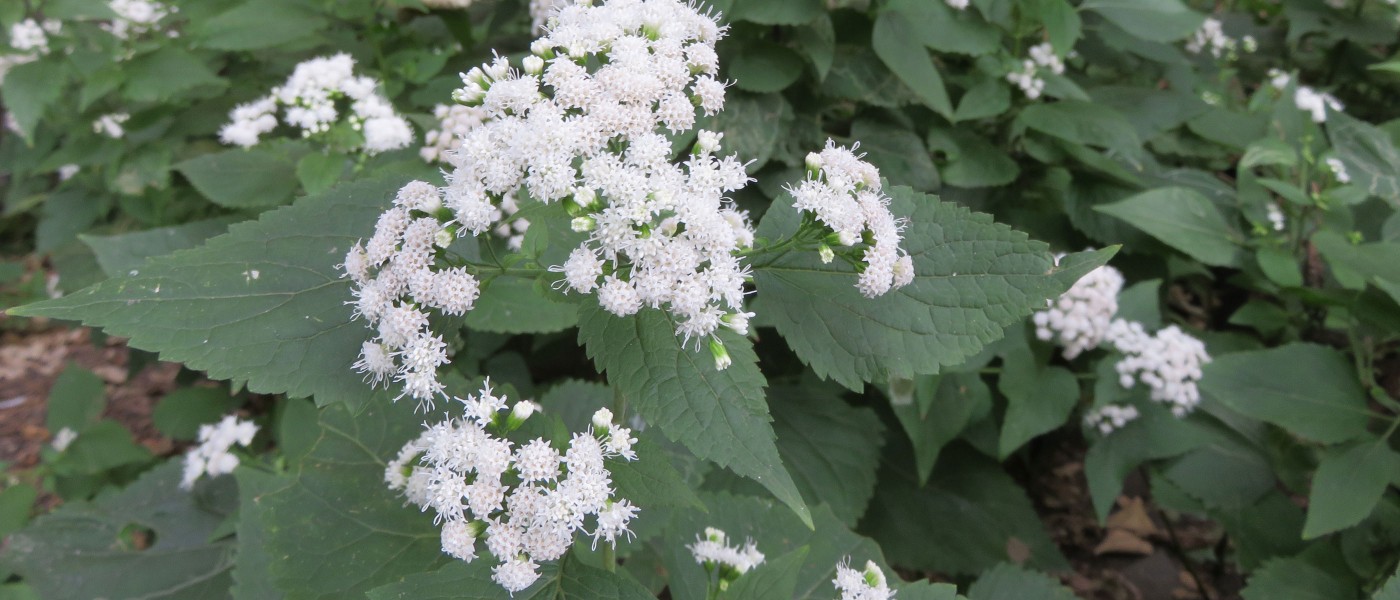Weed of the Month: White Snakeroot
Fall-blooming white snakeroot is that nondescript weed that has been inconspicuously growing in shady spots all spring and summer. You barely notice the one- to four-foot-tall plant with toothy, dark green leaves until suddenly—poof! It’s everywhere you turn, all abloom with fluffy white flowers. One of the last wild natives to flower, Ageratina altissima is a godsend to hungry insects like bees, moths, and flies furiously foraging before the weather turns cold and food becomes scarce.
After blooming, its seeds are dispersed primarily by wind, their fuzzy tails carrying them far and wide. The plant also spreads by rhizomes (underground stems), so you’re as likely to see a colony as a single specimen. Originally a woodland plant, white snakeroot is also perfectly at home in the sidewalks, vacant lots, and shady gardens of Brooklyn.
Sadly, white snakeroot played an unfortunate role in American history. In the early 19th century, European settlers, unfamiliar with the plant, allowed cows and other domestic animals to feed on it. A toxin in the plant called tremetol tainted the cow’s milk, causing sickness and death to those who drank it, calves as well as humans. Milk sickness, as it was called, claimed the lives of thousands of people, including, it is thought, Abraham Lincoln’s mother. Native Americans, who made poultices with snakeroot, knew of its toxic properties, but their botanical knowledge was frequently overlooked by settlers, to their detriment.
Eventually, a frontier doctor in Illinois named Anna Pierce Hobbs Bixby learned of the cause of the sickness from a Shawnee medicine woman. Bixby helped control the disease locally by instructing settlers to remove white snakeroot from their fields, but she too was largely ignored by the medical community, and research confirming the connection between snakeroot and milk was only published much later. Today, for better or worse, industrial agriculture has all but eradicated milk sickness. Since milk from thousands of cows is now combined when processed, the occasional toxin-containing contribution would be diluted to harmless levels.
White snakeroot is most easily identifiable in the fall, when its fluffy white flower heads appear, but it has another distinctive characteristic that appears when it leafs out in spring. Look for elaborate, curving trails on some leaves. These are the work of a species of fly (Liriomyza eupatoriella) that makes white snakeroot its host. The fly lays its eggs on the leaf, and after they hatch, the larvae feed on the leaf tissue, tunneling their way around and creating the beautiful, albeit destructive patterns. Vegetable gardeners may recognize these patterns as the telltale sign of leaf miners that attack their chard, beet, spinach, and tomato plants in much the same way. The intricate tunnels don't do these plants any good, though white snakeroot seems better able to tolerate them than some other species. Another wondrous peek into the complexities of nature: The same plant that could kill a cow is baby food for a tiny fly!
The Weed of the Month series explores the ecology and history of the common wild plants that most gardeners consider weeds.


